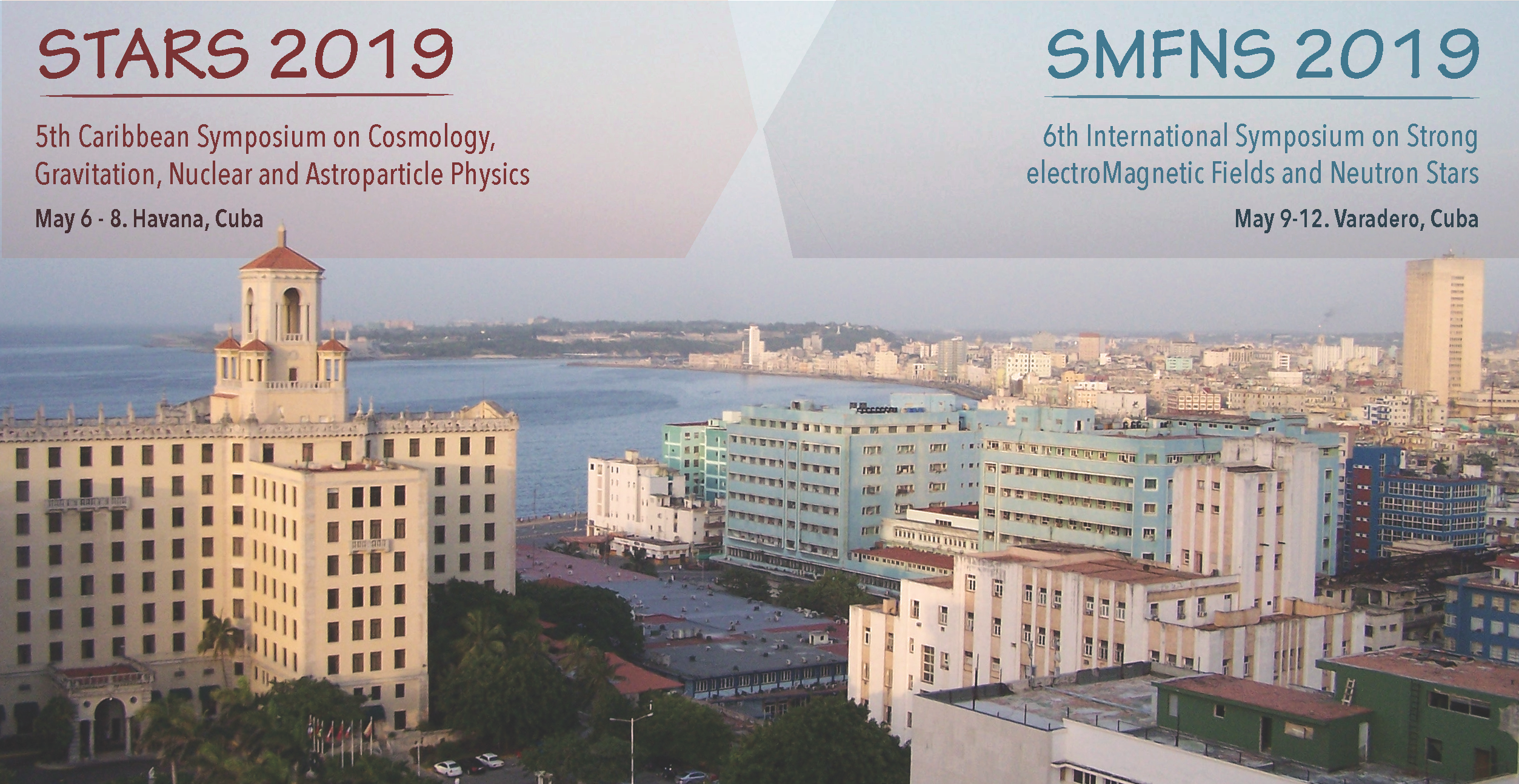- Compact style
- Indico style
- Indico style - inline minutes
- Indico style - numbered
- Indico style - numbered + minutes
- Indico Weeks View
STARS2019 / SMFNS2019
→
Cuba
Museum Casa de los Árabes
Museum Casa de los Árabes
Ofícios 16, Havana 10100, Old Havana
, , , , , ,
Description
The events are the fifth and sixth in a series of meetings gathering scientists working on astroparticle physics, cosmology, gravitation, nuclear physics, and related fields. As in previous years, the meeting sessions will consist of invited and contributed talks and will cover recent developments in the following topics:
STARS2019 – New phenomena and new states of matter in the Universe, general relativity, gravitation, cosmology, heavy ion collisions and the formation of the quark-gluon plasma, white dwarfs, neutron stars and pulsars, black holes, gamma-ray emission in the Universe, high energy cosmic rays, gravitational waves, dark energy and dark matter, strange matter and strange stars, antimatter in the Universe, and topics related to these.
SMFNS2019 – Strong magnetic fields in the Universe, strong magnetic fields in compact stars and in galaxies, ultra-strong magnetic fields in neutron star mergers, quark stars and magnetars, strong magnetic fields and the cosmic microwave background, and topics related to these.
As part of the events, the school Relativistic Astrophysics and Connected Problems will be held in ICIMAF, Havana, 3 - 4 May, for students and young researchers. Registration and participation in the school are free of charge.
Professor Walter Greiner Award will be granted to the best three posters presented by students at the conferences.
Organizing Committee:
- Aurora Pérez Martínez – Instituto de Cibernética, Matemática y Física (ICIMAF), Cuba - Co-Chair
- Alejandro Cabo Montes de Oca – Instituto de Cibernética, Matemática y Física (ICIMAF), Cuba
- Bruna Cesira Folador – Universidade Federal do Rio Grande do Sul (UFRGS), Brazil
- César A. Zen Vasconcellos – Universidade Federal do Rio Grande do Sul (UFRGS), Brazil - Chair
- Christian Motch – Centre National de la Recherche Scientifique (CNRS), France
- Daryel Manreza Paret – Universidad de La Habana (UH), Cuba
- Diana Alvear Terrero – Instituto de Cibernética, Matemática y Física (ICIMAF), Cuba and University of Wroclaw (UWr), Poland
- Elizabeth Rodríguez Querts – Instituto de Cibernética, Matemática y Física (ICIMAF), Cuba
- Gabriella Piccinelli – Universidad Nacional Autónoma de México (UNAM), Mexico
- Gretel Quintero Angulo – Universidad de La Habana (UH), Cuba
- Hugo Pérez Rojas – Instituto de Cibernética, Matemática y Física (ICIMAF), Cuba
- Marcus Bleicher – HIC for FAIR, Germany
- Matthias Kaminski – University of Alabama, USA
- Ricardo González Felipe – Instituto Superior de Engenharia de Lisboa (ISEL) and Centro de Física Teórica de Partículas (CFTP)/Instituto Superior Técnico (IST), Lisboa, Portugal - Co-Chair
- Thomas Boller – Max-Planck Institute, Germany
International Advisory Committee:
- Alejandro Ayala – UNAM, Mexico
- Carola Dobrigkeit – Universidade de Campinas (UNICAMP), Brazil
- Constança Providência – UC, Portugal
- Dany Page – UNAM, México
- David Blaschke – UWr, Poland
- David Valls-Gabaud – CNRS & Observatoire de Paris, France
- Débora Peres Menezes – UFSC, Brazil
- Dimiter Hadjimichef – UFRGS, Brazil
- Eduardo Guendelman – BGU, Israel
- Elena Bratkovskaya – GSI/JWGU, Germany
- Eric Gourgoulhon – LUTH, CNRS & Observatoire de Paris, France
- Ernesto Kemp – UNICAMP, Brazil
- Félix Mirabel – IAFE/CONICET, Argentina
- Fernando Quevedo – ICTP, Italy
- Fridolin Weber – SDSU, USA
- Géraldine Conti – CERN, Switzerland
- Horst Stoecker – GSI, FIAS & JWGU, Germany
- Ignatios Antoniadis – CERN, Switzerland
- Joerg Aichelin – SUBATECH, France
- José A. de Freitas Pacheco – OCA, France
- Jose Francisco Morales – U. Rome Tor Vergata, Italy
- Katharina Müller – PIUZ & CERN, Switzerland
- Leopoldo Pando Zayas – U-M, USA
- Magno V. Trindade Machado – UFRGS, Brazil
- Marcela Carena – Fermilab, USA
- Marcus Bleicher – HIC for FAIR, Germany
- Massimo Della Valle – AOC, Italy
- Miguel Alcubierre – UNAM, Mexico
- Norberto Scoccola – Tandar/CNEA, Argentina
- Norman K. Glendenning - LBNL, USA
- Pascal Chardonnet – US, France
- Peter O. Hess – UNAM, Mexico
- Rafael Nepomechie – UM, USA
- Remo Ruffini – ICRANet, Italy
- Renxin Xu – PKU, China
- Roberto A. Sussman – UNAM, Mexico
- Sergei B. Popov – SAI/MSU, Russia
- Siannah Peñaranda Rivas – UNIZAR, Spain
- Stefan Schramm – FIAS/JWGU, Germany
- Tsvi Piran – HU, Israel
- Ulisses Barres de Almeida – CBPF, Brazil
Local Organizers:
- Aurora Pérez Martínez – ICIMAF, Cuba
- Alejandro Cabo Montes de Oca – ICIMAF, Cuba
- Daryel Manreza Paret – UH, Cuba
- Diana Alvear Terrero – ICIMAF, Cuba and UWr, Poland
- Elizabeth Rodríguez Querts – ICIMAF, Cuba
- Gretel Quintero Angulo – ICIMAF, Cuba
Support
Participants
Adrian Linares-Rodríguez
Adrian William Romero Jorge
Alejandro Cabo Montes de Oca
Andres Escala
Angel Sanchez
Aurora Perez Martinez
Christian Spieles
Christian Sturm
Dairon Rodríguez Garcés
Danilo Diaz
Dario Ramirez
Daryel Manreza Paret
David Edwin Alvarez Castillo
Diana Alvear Terrero
Duvier Fontanella
Eduardo Guendelman
Elena Bratkovskaya
Elizabeth Rodríguez Querts
Ernesto Frodden
Ernesto Kemp
Felix Napoleon Diaz Desposorio
Gabriella Piccinelli Bocchi
Gretel Quintero Angulo
Hajime Sotani
Hugo Celso Perez Rojas
Jessica Gullberg
Joerg Aichelin
Jorge Luis Dominguez Martinez
Josue Motoa Manzano
Lismary de la Caridad Suárez González
Marcelo Enrique Rubio
Marco Antonio Arroyo Ureña
Marcus Bleicher
Martin Land
Martin Roth
Miguel Angel Marquina Carmona
Norbert Christlieb
Osvaldo Bezerra Silva Junior
Paula Christine Hillmann
Peter Hess
Ramzi Suleiman
Ricardo Gonzalez Felipe
Rogerio de Almeida
Rolando Cardenas
Samantha López
Satoru Katsuda
Steven Gullberg
Thomas Boller
Tom Reichert
Tomoya Takiwaki
Victor Alexander Torres Sanchez
Yeinzon Rodriguez Garcia
Zhifu Gao
